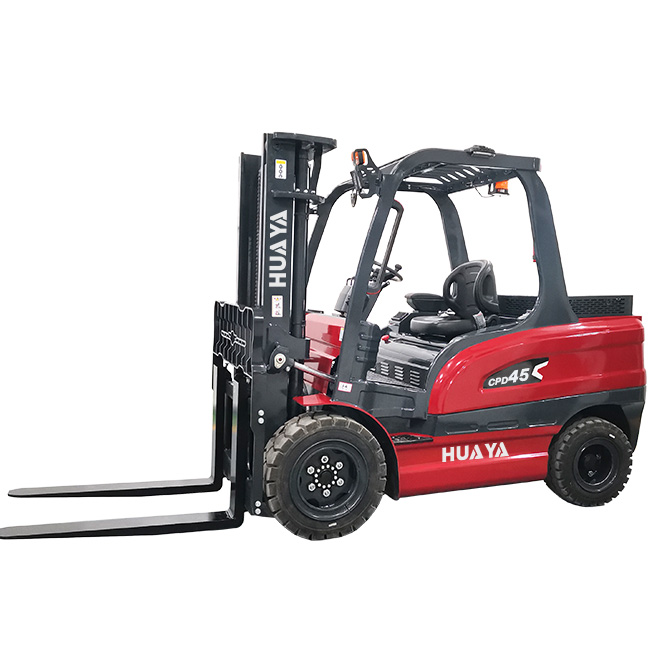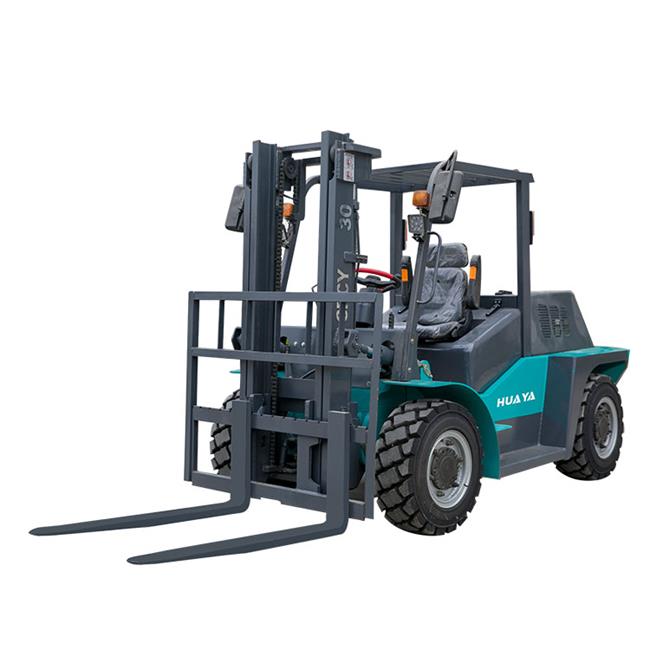
News
Industrial forklifts are indispensable machines in various industries, known for their ability to lift and transport heavy loads. However, when selecting a forklift, one of the key considerations is how much weight it can handle. The lifting capacity of a forklift determines its efficiency, productivity, and safety in a given work environment. This article the factors affecting forklift lifting capacity, different types of forklifts, and how businesses can select the right machine for their needs.
An industrial forklift is a powered vehicle designed to lift, move, and transport heavy materials over short distances. Forklifts are equipped with a hydraulic lifting mechanism that enables them to raise and lower loads, making them an essential tool in warehouses, factories, and construction sites.
Forklifts are used in a wide variety of industries, including manufacturing, construction, and warehousing. They assist in moving goods, loading and unloading trucks, stacking products, and organizing materials in storage areas. Their versatility makes them a key player in improving operational efficiency.
The lifting capacity of a forklift is crucial because it determines how much weight the machine can safely lift and move. Overloading a forklift can lead to accidents, equipment damage, and safety hazards, making it essential to choose a machine with the appropriate capacity for the job.
Different types of forklifts are designed for different lifting capacities. For example, electric forklifts are typically used for lighter loads, while diesel forklifts are built to handle much heavier weights. Terrain forklifts are designed for rough outdoor environments and can carry heavy loads over uneven surfaces.
The type of attachments used with a forklift can affect its lifting capacity. Attachments like clamps, side shifters, or rotators may reduce the overall weight a forklift can lift because of the added weight of the attachment itself. It’s important to calculate these adjustments when determining the forklift's effective lifting capacity.
The load center is the distance from the forklift's mast to the center of gravity of the load being lifted. As the load center increases, the forklift's lifting capacity decreases. Therefore, it’s essential to place loads correctly to maintain the forklift's full lifting potential.

Electric forklifts are powered by batteries and are generally quieter, more environmentally friendly, and easier to maintain than internal combustion engine forklifts. These forklifts are often used in indoor environments such as warehouses and retail stores.
Electric forklifts typically have a lifting capacity ranging from 1 to 7 tons. Smaller models are used for lightweight loads, while larger models are suitable for heavier goods in industrial settings.
Electric forklifts offer several advantages, such as zero emissions, lower operating costs, and quieter operation. They are ideal for indoor use where air quality and noise levels are concerns.
One limitation of electric forklifts is their lower lifting capacity compared to diesel or gas-powered models. Additionally, they require charging, which can result in downtime if not managed properly.

Diesel forklifts are powered by diesel engines, making them suitable for outdoor and heavy-duty applications. They are typically used in construction, agriculture, and other industries that require robust equipment.
Diesel forklifts have a much higher lifting capacity than electric models, ranging from 1 to 15 tons or more. These forklifts are designed for handling extremely heavy loads in rugged environments.
Diesel forklifts are durable, powerful, and capable of operating in harsh conditions. They have a longer operating time and are ideal for large-scale outdoor operations, such as moving heavy construction materials or large industrial loads.
While diesel forklifts offer high lifting capacities, they are noisy, emit fumes, and require more maintenance than electric models. Their emissions also make them unsuitable for indoor use.

Terrain forklifts, also known as all-terrain or rough-terrain forklifts, are specifically designed for operating on uneven and rugged surfaces. They are commonly used in construction sites, farms, and outdoor events.
Terrain forklifts have lifting capacities ranging from 3 to 10 tons. Their robust design allows them to carry heavy loads over difficult terrain without compromising stability.
These forklifts are built for challenging environments where other machines might struggle. They feature larger tires, reinforced frames, and more powerful engines to navigate uneven surfaces while carrying heavy loads.
Terrain forklifts tend to be larger, bulkier, and less maneuverable in confined spaces. Their fuel consumption and emissions can also be higher compared to other types of forklifts.
A forklift load chart is a guide that provides information on how much weight a forklift can lift under different conditions. It factors in the load center, height, and the type of attachment being used. Load charts are essential for determining whether a forklift can safely lift a specific load.
To read a load chart, identify the load center and lifting height, then cross-reference these with the chart to find the maximum allowable weight. Load charts also specify how different attachments or accessories affect the forklift's lifting capacity.
Understanding and following the load chart is critical for ensuring safe forklift operation. Misjudging a forklift's lifting capacity can lead to accidents, tipping, and damage to both the load and the equipment.
The load center is the horizontal distance from the front of the forklift's forks to the center of gravity of the load being lifted. Standard load centers are typically 24 inches for most forklifts, but this can vary depending on the type of load.
As the load center increases, the forklift's ability to lift heavy weights decreases. Loads that are positioned too far from the forklift’s mast shift the center of gravity and can cause instability, leading to accidents or equipment damage.
Properly placing loads close to the forklift's mast ensures that the machine can operate at its full capacity. Incorrect placement not only reduces lifting capacity but also puts the operator and surrounding workers at risk.
Forklift attachments come in many forms, such as clamps, rotators, and sideshifters. These attachments allow forklifts to handle specific tasks, like rotating loads or clamping down on products that cannot be easily lifted with standard forks.
Attachments add weight to the forklift, which reduces the overall lifting capacity. For example, a forklift with a clamp attachment might lose 10-15% of its rated lifting capacity. Operators should always consider the weight of attachments when calculating the safe load limit.
Selecting the right attachment ensures that the forklift can perform its tasks efficiently without compromising safety. Different industries may require specific attachments, so it's important to match the attachment to the job at hand.
Operators should be properly trained to understand a forklift’s lifting capacity and how to operate it safely. Training should include how to read load charts, position loads correctly, and assess the conditions in which the forklift is being used.
Regular maintenance is essential for ensuring that a forklift operates at its maximum lifting capacity. Routine inspections can help identify any wear and tear that could compromise the forklift's ability to lift heavy loads.
Operators should never exceed a forklift's rated capacity. Overloading a forklift can cause tipping, loss of control, and damage to the machine and load. Always refer to the forklift’s load chart and consider any attachments when calculating the safe lifting capacity.
Forklift stability is affected by factors such as the load center, tire condition, and the forklift's overall balance. Uneven ground, sloped surfaces, or sharp turns can also impact the forklift's stability, especially when lifting heavy loads.
The stability triangle is a concept used to describe the balance of a forklift. The triangle is formed between the front wheels and the center of gravity of the forklift and its load. Keeping the center of gravity within this triangle ensures stability during operation.
To maintain forklift stability, operators should ensure loads are evenly distributed and placed close to the mast. Additionally, they should avoid sudden movements, sharp turns, and operating on uneven surfaces.
Before purchasing a forklift, it’s important to assess the types of loads you will be handling, including weight, dimensions, and load center. This will help you choose a forklift with the appropriate lifting capacity for your operations.
The work environment plays a crucial role in selecting the right forklift. For indoor operations, electric forklifts are ideal due to their low emissions and quiet operation. For outdoor or rough terrain environments, diesel or terrain forklifts are more suitable.
Different tasks may require specific attachments, such as clamps or side shifters. When selecting a forklift, consider the types of attachments you may need and how they will impact the lifting capacity.
Understanding how much an industrial forklift can lift is essential for ensuring safe and efficient operations. By considering factors such as the type of forklift, load center, attachments, and environment, businesses can select the right machine for their needs. Always adhere to the manufacturer's guidelines, maintain proper operator training, and ensure regular equipment maintenance to get the most out of your forklift while minimizing risks.


